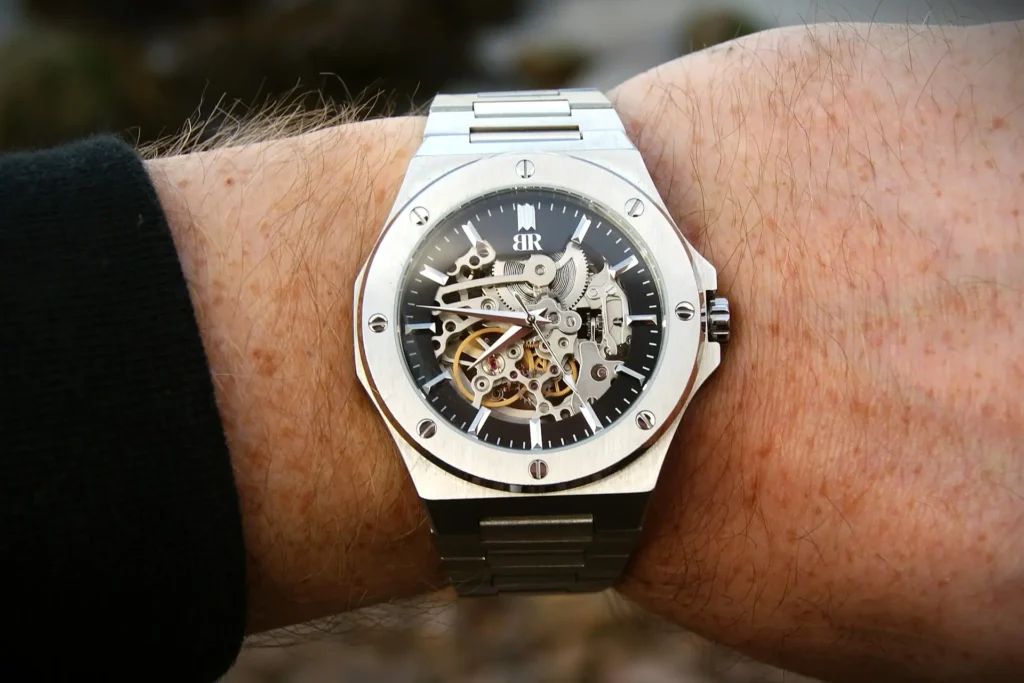Skeleton Watches 101: Benefits, Drawbacks & Expert Tips
Ever seen those watches where you can see all the gears moving inside? They’re called skeleton watches, and they’re pretty cool. You can actually watch how they work through the clear front, seeing all the tiny parts moving together to keep time.
If you’re thinking about getting one, this guide will help you figure out if it’s worth your money. We’ll look at what makes them special, what to watch out for, and which ones are good buys at different prices – from $250 all the way up to $5000+. No fancy talk, just straight answers about these see-through watches.
Let’s look at what these watches are all about and if one might be right for you.
Contents
What Makes a Watch “Skeletal”?
A skeleton watch isn’t just a timepiece with holes punched in it. It’s a carefully engineered design that reveals the intricate mechanical ballet happening inside. The watchmaker deliberately removes excess material from the movement plates and bridges, leaving only the essential structure needed to keep the watch running.

Think of it like looking at an X-ray of a regular watch – you can see all the gears, springs, and wheels working together. The main plate, which acts as the foundation, is cut away to reveal these components while maintaining structural integrity.
Why Are They Gaining Such Momentum?
The rising popularity of skeleton watches stems from several factors:
- Our growing appreciation for mechanical craftsmanship in an increasingly digital world. When everyone’s carrying smartphones, wearing a skeleton watch makes a different kind of statement. It says you value tradition, engineering, and artistry.
- Social media’s influence in showcasing these photogenic timepieces
- The watch industry’s push toward transparency (literally and figuratively)
- A renewed interest in understanding how things work
The Real Benefits of Owning a Skeleton Watch
1. A Living Piece of Art
Unlike standard watches, skeleton timepieces offer constant entertainment. Watch the balance wheel oscillate, the mainspring unwind, and the gear train transfer power – it’s like having a tiny kinetic sculpture on your wrist.
2. Educational Value
Many watch enthusiasts started their horological journey with a skeleton watch. Seeing the mechanics in action helps understand concepts like:
- How mechanical energy transfers through the gear train
- The role of the escapement in regulating time
- The function of the balance wheel and hairspring
3. Conversation Starter
In my experience, skeleton watches often spark interesting discussions. Whether you’re at a business meeting or a social gathering, these timepieces naturally draw attention and questions.
Potential Drawbacks of Skeleton Watches
1. Legibility
Let’s be honest – reading time on a skeleton watch can be tricky. The exposed mechanics can make it difficult to distinguish the hands from the background. Some manufacturers address this by using contrasting hand colors or adding partial dials.
2. Maintenance Requirements
Dust is the enemy of any mechanical watch, but skeleton watches are particularly vulnerable. Their open design means more exposure to the elements. Regular cleaning is essential, typically requiring:
- Professional cleaning every 2-3 years
- Careful storage in a watch box when not worn
- Avoiding exposure to water beyond the rated resistance
3. Price Considerations
Quality skeleton watches generally cost more than their standard counterparts. This is because:
- The skeletonization process requires additional skilled labor
- More precision is needed as the movement is visible
- Higher-grade finishing is required on exposed components
How to Choose Your First Skeleton Watch
1. Movement Type Matters
Automatic movements offer convenience but can partially obstruct the view with the rotor. Manual-wind movements provide clearer views but require daily winding. Consider your preference for interaction with your watch.
2. Size Considerations
Skeleton watches often wear larger than their specifications suggest. A 40mm skeleton watch might feel more prominent than a 40mm standard watch due to the visual complexity. For most wrists, 38-42mm provides a good balance.
3. Price Range Guide
Based on current market analysis:
Entry Level ($250-500):
Mid-Range ($1,000-2,500):
Luxury ($5,000+):
The Future of Skeleton Watches
The skeleton watch trend shows no signs of slowing down. Manufacturers are incorporating new materials and techniques while maintaining the traditional appeal of mechanical movements. We’re seeing more affordable options with quality movements, making skeleton watches accessible to a broader audience.
Should You Get One?
A skeleton watch might be right for you if:
- You appreciate mechanical engineering
- You’re looking for a unique conversation piece
- You enjoy watching intricate mechanisms at work
- You don’t mind some extra maintenance
However, consider alternatives if:
- You prioritize instant time readability
- You need robust water resistance
- You prefer minimal maintenance
- You’re working with a limited budget
Final Thoughts
Skeleton watches represent more than just timekeepers – they’re a celebration of mechanical artistry. While they require more care and consideration than standard watches, the unique experience they offer makes them worth exploring for many watch enthusiasts.
Whether you’re a seasoned collector or just starting your watch journey, understanding these timepieces helps make an informed decision. Remember, the best skeleton watch is one that matches your lifestyle, budget, and appreciation for mechanical craftsmanship.
Choose wisely, maintain properly, and you’ll have a fascinating timepiece that does more than tell time – it shows you how time works.